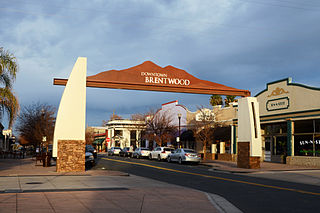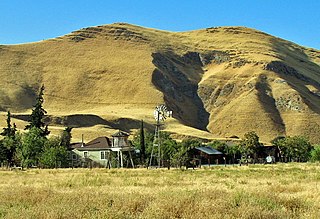
Contra Costa County is a county located in the U.S. state of California, in the East Bay of the San Francisco Bay Area. As of the 2020 United States Census, the population was 1,165,927. The county seat is Martinez. It occupies the northern portion of the East Bay region of the San Francisco Bay Area and is primarily suburban. The county's name refers to its position on the other side of the bay from San Francisco. Contra Costa County is included in the San Francisco–Oakland–Berkeley, CA Metropolitan Statistical Area.

Antioch is the third-most populous city in Contra Costa County, California, United States. The city is located in the East Bay region of the San Francisco Bay Area along the Sacramento–San Joaquin River Delta. The city's population was 115,291 at the 2020 census. The city has grown substantially more diverse since the 1970s.

Bay Point, formerly West Pittsburg and originally Bella Vista is a census-designated place located in the East Bay region of the San Francisco Bay Area in Contra Costa County, California. Bay Point is just west of Pittsburg, California, and northeast of Concord, California, on the southern shore of Suisun Bay. The population of Bay Point was 21,349 as of 2010. The Pittsburg/Bay Point Station of the Bay Area Rapid Transit (BART) rail system is located adjacent to Bay Point in Pittsburg. The community is traversed by a freeway, State Route 4, the California Delta Highway. Being unincorporated, Bay Point does not have its own police department. The community is policed by the California Highway Patrol and the Contra Costa County Sheriff's Office. The ZIP code is 94565, and the area code is 925.

Brentwood is a city in Contra Costa County, California, United States. It is located in the East Bay region of the San Francisco Bay Area. The population is 66,854 as of 2022, an increase of 287% from 23,302 at the 2000 census.

Hercules is a city in western Contra Costa County, California. Situated along the coast of San Pablo Bay, it is located in the eastern region of the San Francisco Bay Area, about 10 miles (16 km) north of Berkeley. As of the 2020 census, its population was 26,016, according to the United States Census Bureau. The site of Hercules was first developed in 1881 as a manufacturing facility of the California Powder Works for the production of its patented dynamite formulation, Hercules powder. In 1882, the Hercules Powder Company was incorporated and assumed responsibility for the Hercules site. It was one of several explosive manufacturers that were active along the Pinole shoreline in the late 19th to the mid-20th century. The small company town that grew up near the facility subsequently became known as "Hercules", and was incorporated at the end of 1900. Starting in the 1970s, Hercules was heavily redeveloped as suburban bedroom community that lies along the I-80 corridor in Western Contra Costa County. It has a very ethnically diverse population.

Oakley is a city in Contra Costa County, California, United States. It is within the nine-county San Francisco Bay Area. The population at the 2020 United States census was 43,357. Oakley was incorporated in 1999, making it the newest incorporated city in Contra Costa County.

Pittsburg is a city in Contra Costa County, California, United States. It is an industrial suburb located on the southern shore of the Suisun Bay in the East Bay region of the San Francisco Bay Area, and is part of the Sacramento–San Joaquin River Delta area, the Eastern Contra Costa County area, and the San Francisco Bay Area. The population was 76,416 at the 2020 United States Census.

The East Bay Regional Park District (EBRPD) is a special district operating in Alameda County and Contra Costa County, California, within the East Bay area of the San Francisco Bay Area. It maintains and operates a system of regional parks which is the largest urban regional park district in the United States. The administrative office is located in Oakland.

The East Bay is the eastern region of the San Francisco Bay Area and includes cities along the eastern shores of the San Francisco Bay and San Pablo Bay. The region has grown to include inland communities in Alameda and Contra Costa counties. With a population of roughly 2.8 million in 2024, it is the most populous subregion in the Bay Area, containing the second- and third-most populous Bay Area counties of Alameda and Contra Costa.

The John Muir National Historic Site is located in the San Francisco Bay Area, in Martinez, Contra Costa County, California. It preserves the 14-room Italianate Victorian mansion where the naturalist and writer John Muir lived, as well as a nearby 325-acre tract of native oak woodlands and grasslands historically owned by the Muir family. The main site is on the edge of town, in the shadow of State Route 4, also known as the "John Muir Parkway."

The Sacramento Northern Railway was a 183-mile (295 km) electric interurban railway that connected Chico in northern California with Oakland via the state capital, Sacramento. In its operation it ran directly on the streets of Oakland, Sacramento, Yuba City, Chico, and Woodland. This involved multiple car trains making sharp turns at street corners and obeying traffic signals. Once in open country, SN's passenger trains ran at fairly fast speeds. With its shorter route and lower fares, the SN provided strong competition to the Southern Pacific and Western Pacific Railroad for passenger business and freight business between those two cities. North of Sacramento, both passenger and freight business was less due to the small town agricultural nature of the region and due to competition from the paralleling Southern Pacific Railroad.

Deer Valley High School in Antioch, California, is a public secondary school serving southeast Antioch in Contra Costa County, California. It opened in 1996.

The Black Diamond Mines Regional Preserve is a 6,000-acre (2,400 ha) park located north of Mount Diablo in Contra Costa County, California under the administration of the East Bay Regional Park District (EBRPD). The district acquired the property in 1973. The preserve contains relics of 3 mining towns, former coal and sand mines, and offers guided tours of a former sand mine. The 60 miles (97 km) of trails in the Preserve cross rolling foothill terrain covered with grassland, California oak woodland, California mixed evergreen forest, and chaparral.

The Contra Costa Canal is a 47 mi (76 km) aqueduct in the US state of California. Its construction began in 1937, with delayed completion until 1948 due to World War II shortages in labor and materials. A portion of the canal's right of way has been developed as the Contra Costa Canal Regional Trail, a biking and walking trail, and is managed by the East Bay Regional Park District.

This is a list of the National Register of Historic Places listings in Contra Costa County, California.
Rancho Laguna de Los Palos Colorados was a 13,316-acre (53.89 km2) Mexican land grant in the Berkeley Hills within present-day Contra Costa County, California.

The Contra Costa County Superior Court, officially known as the Superior Court of California, County of Contra Costa, is the California Superior Court with jurisdiction over Contra Costa County. It has four courthouses: Martinez, Pittsburg, Richmond and Walnut Creek.

The Roswell Butler Hard House is a house located at 815 W. First St. in Antioch, California. Roswell Butler Hard, a prominent early resident of Antioch, built the house in 1869. Hard was the first chairman of the Antioch town council, which originally met in his house; he also served as county sheriff and supervisor. The two-story Italianate house was built entirely from brick made in the city. It was split into smaller housing units after Hart's death; in 1979, the city of Antioch took ownership of the building, and it has fallen into disuse since.

The Don Fernando Pacheco Adobe is located at 3119 Grant Street in Concord, California.The Fernando Pacheco Adobe is the only Concord landmark listed in all three Historical Registries: entry on the National Register occurred on June 6, 1980; the California Registered landmark number is 455; and the Concord Historical Landmark designation is 1-26-26/5458. The Adobe was built by Don Fernando in the early 1850s as the base of operations for his growing ranch activities, and as his family's formal residence. Fernando was the oldest son of Don Salvio Pacheco. He was born on May 30, 1818, while his father was assigned to a Militia-Guard unit at the Pueblo of San Jose. At age 17, he was sent to take possession and mark the boundaries of his father's 17,921 acre land grant. Fernando was given 1,500 acres as initial share of the rancho. He subsequently married Pasquala (Figeroa) (Juarez) – a widow. Their six children: Pedro, Bonifacio, Cipriana, Maria Asuncion, Librada and Bersabe were raised at the Adobe. Don Fernando's family enjoyed a reputation as gracious hosts. They were famous for their generosity and extensive fiestas on Adobe's then lush, well irrigated grounds. The Adobe's 32” thick walls were built of local adobe – mud.

The Moraga Adobe is located at 24 Adobe Lane in Orinda, California. It was built by Don Joaquin Moraga who was the grandson of Jose Joaquin Moraga an early Spanish explorer in California who founded the city of San Jose, California. In 1835, Mexico granted 13,326 acres (5,393 ha), El Rancho Laguna de los Palos Colorados, to Joaquin Moraga and his cousin Juan Bernal. Six years later in 1841, Joaquin built this house, which is the oldest of the five surviving adobe houses in Contra Costa County. The adobe sits on a knoll at the center of the 20-acre (8.1 ha) property of what is left of the original land grant. The house has been restored and remodeled twice since it was photographed for HABS, first in 1941 when Katharine Brown White Irvine of Oakland, California purchased the old adobe, making additions such as adding three bedrooms and a veranda, and covering the adobe walls and again in 1964 when it was incorporated into a private home. The house is not accessible to the public and it is fenced off. However, it was photographed in 1922 for the Historical American Building Survey (HABS). Today, the Moraga Adobe is privately owned and unoccupied. The overall condition of the original adobe section and the more modern addition is neglected, but the building appears sound. The surrounding property was recently purchased, and the new owners have boarded up the windows to prevent vandalism and trespassing. The Moraga Adobe has been designated as a Historical Landmark by the City of Orinda and the State of California. A campaign has been started to purchase the property and restore the house to its 1848 configuration, to be used as a museum and educational site.





















